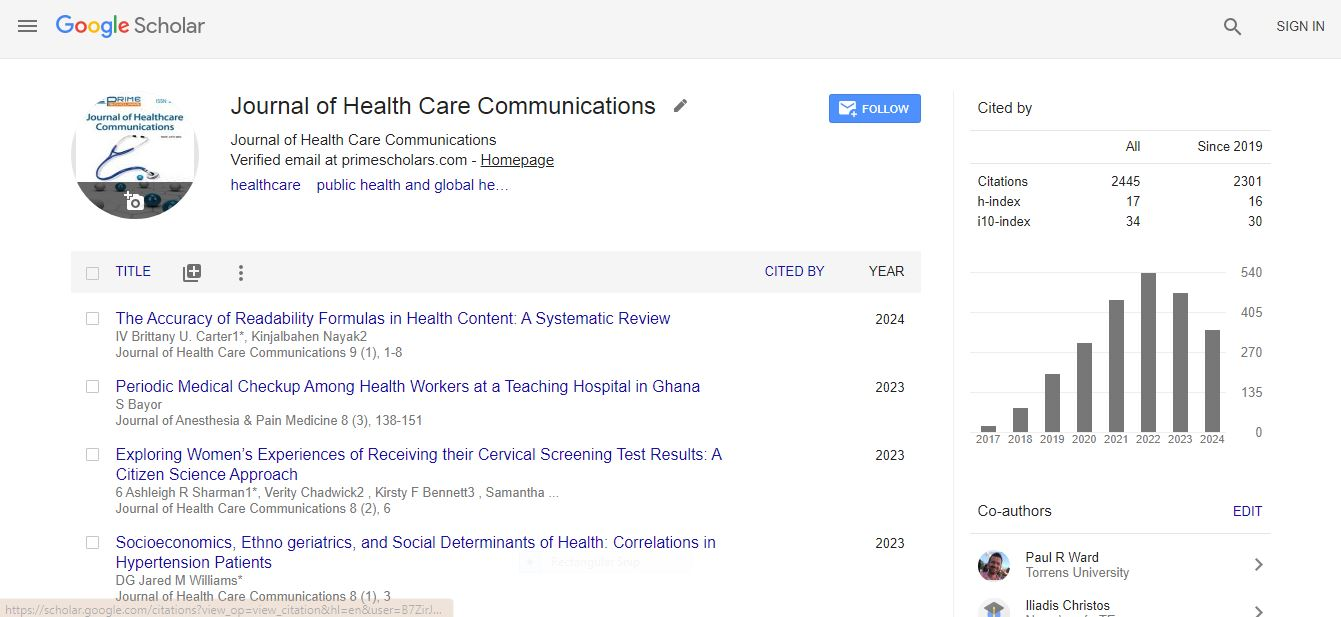Short Communication - (2025) Volume 10, Issue 2
Mental Health Care: Building Trust and Connection Through Communication
Mitchell Luke*
Department of Health Informatics, University College London, London, United Kingdom
*Correspondence:
Mitchell Luke, Department of Health Informatics, University College London, London,
United Kingdom,
Email:
Received: 03-Jun-2025, Manuscript No. IPJHCC-25-22777;
Editor assigned: 05-Jun-2025, Pre QC No. IPJHCC-25-22777 (PQ);
Reviewed: 19-Jun-2025, QC No. IPJHCC-25-22777;
Revised: 26-Jun-2025, Manuscript No. IPJHCC-25-22777 (R);
Published:
03-Jul-2025, DOI: 10.36846/2472-1654.25.10.70
Description
Mental health care is one of the most communicationdependent areas of healthcare. Unlike many physical health conditions that can be diagnosed through laboratory tests or imaging, mental health conditions rely heavily on dialogue between patients and providers. Clear, empathetic and consistent communication forms the foundation for effective diagnosis, treatment planning and long-term support.
A key aspect of mental health communication is building trust. Patients often approach mental health providers with hesitation due to stigma, fear of being misunderstood, or past negative experiences [1-3]. The way a provider listens, responds and validates the patient’s feelings sets the tone for the therapeutic relationship. Active listening, maintaining non-judgmental attitudes and using language that conveys respect are essential for establishing trust. Without this foundation, patients may withhold important information or disengage from treatment.
Another dimension is the role of communication in assessment and diagnosis. Mental health professionals rely on structured interviews, patient self-reports and observation to form a clinical picture. However, patients may struggle to articulate their thoughts or feelings, especially when dealing with anxiety, depression, or psychosis. Providers must be skilled in asking open-ended questions, guiding conversations gently and recognizing non-verbal cues such as tone of voice, posture and facial expressions [4]. These subtle details often provide insights that cannot be captured in standardized questionnaires alone.
Treatment adherence in mental health care is also closely tied to communication. Patients who feel that their concerns are heard and that treatment options are explained in understandable terms are more likely to follow therapy or medication regimens. Conversely, when communication is rushed or overly technical, patients may feel disconnected from their treatment plans and discontinue care. Clear explanations of potential side effects, expected outcomes and available alternatives empower patients to make informed choices and remain engaged [5].
Family involvement often plays a significant role in mental health care. Providers frequently need to communicate with family members or caregivers to support treatment. This requires balancing patient confidentiality with the need for family engagement. Sensitive discussions about progress, challenges and support strategies must be handled with care to maintain trust and respect for the patient’s autonomy. Involving families appropriately can enhance treatment outcomes, but only if the communication is respectful and collaborative.
Cultural perspectives further shape mental health communication. In some societies, mental illness carries a strong stigma and individuals may describe symptoms in physical rather than emotional terms. Providers must recognize these cultural nuances and adapt their communication strategies accordingly. Using culturally relevant examples, offering multilingual resources and respecting traditional beliefs help reduce barriers and create more inclusive care environments [6-8].
Technology has added new layers to mental health communication through telepsychiatry and digital therapy platforms. These services expand access, particularly for patients in remote or underserved areas. However, online communication lacks some of the non-verbal cues present in face-to-face interactions. Providers must learn to adapt their approaches, ensuring that empathy, clarity and attentiveness are not lost in virtual settings. Clear guidelines about privacy and confidentiality in online sessions are also essential for building patient confidence.
Crisis communication is another critical element in mental health care. Providers may need to respond to patients experiencing suicidal thoughts, severe panic attacks, or psychotic episodes. In such cases, communication must be calm, direct and reassuring [9]. Training in crisis intervention techniques equips professionals with the skills to de-escalate situations and connect patients to immediate support services. Failure to handle these moments effectively can have severe consequences for both patient safety and provider accountability.
Stigma reduction campaigns also rely on effective communication. Public health messaging that normalizes conversations around mental health encourages more people to seek care. Peer support programs highlight another dimension of communication in mental health. Patients often find comfort in speaking with others who have lived experiences of mental illness [10]. These conversations foster a sense of belonging and reduce isolation. Integrating peer communication into formal healthcare systems creates a more holistic support network for patients.
Training for mental health professionals increasingly emphasizes communication skills. Courses in motivational interviewing, trauma-informed care and cultural competence strengthen the ability of providers to connect with diverse patient populations. These skills go beyond clinical knowledge, focusing instead on how to create safe spaces where patients feel seen and heard.
The importance of communication in mental health extends to policy as well. Governments and healthcare systems that prioritize mental health services must also invest in communication infrastructure such as hotlines, community outreach programs and awareness campaigns. By making reliable information and support easily accessible, policymakers can encourage early intervention and reduce the burden of untreated mental illness.
Conclusion
Communication is at the heart of mental health care, shaping every stage from assessment to recovery. Through active listening, culturally sensitive dialogue, family involvement and crisis management, providers can build strong therapeutic relationships that improve outcomes. Technology and peer networks add new dimensions, expanding access and support while requiring careful attention to confidentiality and empathy. Beyond clinical practice, public communication plays a role in reducing stigma and encouraging care-seeking. Ultimately, effective communication transforms mental health services into safe, inclusive and empowering environments that support both healing and resilience.
References
- Cyr ME, Etchin AG, Guthrie BJ, Benneyan JC. Access to specialty healthcare in urban versus rural US populations: A systematic literature review. BMC Health Serv Res. 2019;19(1):1-7.
[Crossref] [Google Scholar] [PubMed]
- Williams J, Petersen N, Stoler J (2018) Characterizing the spatial mismatch between intimate partner violence related healthcare services and arrests in Miami-Dade County, Florida. BMC Public Health. 18(10):1-10.
[Crossref] [Google Scholar] [PubMed]
- Pickett KE, Wilkinson RG (2015) Income inequality and health: A causal review. Soc Sci Med. 128:316-326.
[Crossref] [Google Scholar] [PubMed]
- Liu L (2019) China's dusty lung crisis: Rural-urban health inequity as social and spatial injustice. Soc Sci Med. 233:218-228.
[Crossref] [Google Scholar] [PubMed]
- Palozzi G, Schettini I, Chirico A (2020) Enhancing the sustainable goal of access to healthcare: Findings from a literature review on telemedicine employment in rural areas. Sustainability. 12(8):3318.
[Crossref] [Google Scholar]
- Neely AH, Ponshunmugam A (2019) A qualitative approach to examining health care access in rural South Africa. Soc Sci Med. 230 (1):214-221.
[Crossref] [Google Scholar] [PubMed]
- Ptter AJ, Natafgi N, Ullrich F, MacKinney AC. Perceptions of the benefits of telemedicine in rural communities. Perspect Health Inf Manag. 2016:1.
[Google Scholar]
- Shi L, Wurm M, Huang X, Zhong T, Taubenböck H (2020) Measuring the spatial hierarchical urban system in China in reference to the Central Place Theory. Habitat Int. 105(2):102264.
[Crossref] [Google Scholar]
- Aljassim N, Ostini R (2020) Health literacy in rural and urban populations: A systematic review. Patient Educ Couns. 103(10):2142-2154.
[Crossref] [PubMed]
- Banerjee S (2021) Determinants of rural-urban differential in healthcare utilization among the elderly population in India. BMC Public Health. 21(1):1-8.
[Crossref] [Google Scholar] [PubMed]
Citation: Luke M (2025) Mental Health Care: Building Trust and Connection Through Communication. J Health Commun. 10:70.
Copyright: © 2025 Luke M. This is an open-access article distributed under the terms of the Creative Commons Attribution License, which permits unrestricted use, distribution, and reproduction in any medium, provided the original author and source are credited.

